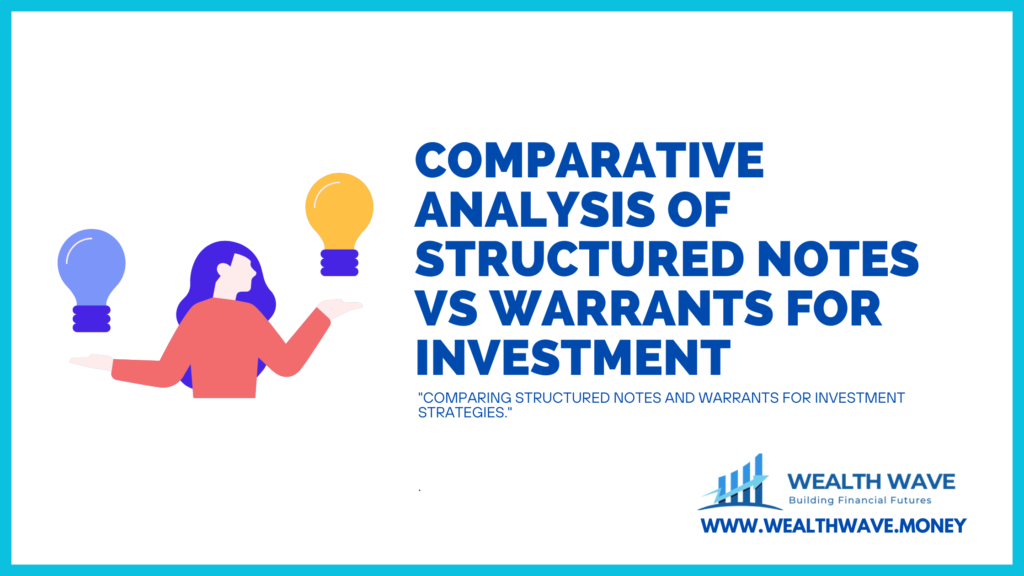Deciding whether to invest in structured notes Vs warrants feels a lot like trying to find your way through a labyrinth without any clues. So many of us end up scratching our heads, wondering which path might lead us closer to our financial dreams.
The universe of derivatives, options, and equity securities isn’t just vast; it’s downright daunting at times. Believe me, we’ve all been there – feeling swamped by the sea of choices the capital markets offer.
But fear not! After diving into research and pooling together our shared wisdom on risk management and structured investments, we’ve uncovered some key insights that could help steer your decision-making process.
It’s crucial to grasp that both structured notes and warrants are part of the larger fabric of structured products with their own intricate derivative layers – yet they cater to differing investor appetites due to their unique characteristics.
Our goal here is to shine a light on these complex financial instruments by breaking down their features, risks, benefits, and overall role in an individual’s investment strategy. Prepare yourself for some much-needed clarity!
Key Takeaways
- Structured notes are investment products that mix bonds and derivatives, providing returns based on an asset’s performance. They offer protection against market downturns but carry issuer credit risk.
- Warrants give the holder the right to buy or sell an underlying asset at a set price before expiry, without mandatory ownership. They can lead to high returns due to their leveraged nature but come with significant risks if the market moves unfavorably.
- Knock-out warrants become worthless if the underlying asset hits a certain price level, while vanilla warrants have straightforward buying and selling rights at predetermined conditions. Understanding these types helps in making informed investment decisions.
- Investing wisely in structured notes or warrants depends on individual investor goals and risk tolerance. While structured notes might suit those looking for some security along with market exposure, warrants appeal more to those seeking higher gains through increased risk.
- Evaluating both instruments carefully is crucial as they significantly differ from traditional investments like stocks or fixed-income securities by including derivative components that influence their risk-return profile.
Understanding Structured Notes
Structured notes are debt securities that offer returns linked to the performance of an underlying asset. They differ from warrants in their built-in protection and credit risk.
Definition
Structured notes are a blend of debt securities and derivative components that create a custom risk-return profile. These financial products, issued by banks and corporate issuers, link the repayment of principal to the performance of an underlying asset, such as equity indexes or a basket of equities.
This unique mixture allows investors to participate in market gains while potentially offering some degree of principal protection. On the other side, warrants, also part of the structured products family, grant the holder the right but not the obligation to buy or sell an asset at a predetermined price before expiration.
Unlike structured notes, warrants share more similarities with equity options than with debt obligations.
We find these investment vehicles appealing for diverse portfolios because they cater to various levels of risk tolerance and investment objectives. Structured notes can offer built-in protection mechanisms against market volatility and credit risks while aiming for positive returns tied to specific assets or benchmarks like equity linked notes or market linked CDs.
Meanwhile, warrants provide investors with leverage opportunities in both bullish and bearish markets without requiring full upfront capital investment as purchasing the underlying asset would entail.
Through understanding these definitions within our investment strategies, we equip ourselves with knowledge on how best to leverage these financial situations to meet individual long-term financial goals.
Structured Notes Vs Warrants: Key Differences
Structured notes and warrants are both types of structured products containing embedded derivative components. Structured notes are debt obligations with an embedded derivative component, adjusting the security’s risk-return profile.
On the other hand, warrants have different characteristics than structured notes and are more similar to options. Warrants provide investors with the right, but not the obligation, to buy or sell an underlying security at a specific price within a defined time frame.
While both products contain embedded derivatives, structured notes primarily function as debt securities with variable returns tied to the performance of an underlying asset or market index.
In contrast, warrants offer investors leverage through exposure to fluctuations in asset prices without having direct ownership of the asset itself.
It is important for investors to carefully consider these differences when evaluating which product aligns best with their investment objectives and risk tolerance.
Returns and Credit Risk
Structured notes and warrants carry differing levels of return and credit risk. Structured notes typically offer higher potential returns compared to traditional fixed-income securities due to their built-in protection mechanisms.
This provides investors an opportunity to participate in the market upside while safeguarding against downside risks. However, it’s essential for investors to carefully evaluate the credit risk associated with structured notes, as they are subject to the creditworthiness of the issuer.
On the other hand, warrants provide exposure to a range of assets and can result in substantial returns if the underlying asset performs well within a specified period. Nonetheless, warrant holders face higher credit risk than structured note holders since warrants do not possess built-in protections against downturns in asset value or changes in interest rates.
Therefore, evaluating these factors is crucial when deciding between structured notes and warrants as part of an investment strategy.
Types of Structured Notes
There are different types of Structured notes, including equity-based, basket-based, and interest rate-based. They provide investors with tailored investment opportunities to navigate the complexities of the ever-changing derivatives market.
Equity-Based
Equity-based structured notes are a type of structured product where the return is linked to the performance of an underlying stock or group of stocks. These structured notes provide investors with exposure to equities while offering downside protection in the form of principal preservation or partial capital protection.
Equity-based structured notes can be designed to track specific indices, individual stocks, or a basket of stocks, allowing investors to diversify their portfolios and potentially benefit from equity market movements.
Investors may consider equity-based structured notes as a way to participate in potential stock market gains while having some level of protection against losses. The structure and features of these products can vary widely, providing investors with choices that align with their risk tolerance and investment objectives.
Additionally, equity-based structured notes offer opportunities for customized investments tailored towards specific market-linked assets, making them suitable for a variety of portfolio strategies within the derivatives market.
Basket-Based
Basket-based structured notes are a type of investment product that offers exposure to a variety of assets within a single note, providing diversification for investors. These structured notes can be linked to different baskets or indexes, such as stock market indices or sectors, allowing investors to gain exposure to multiple underlying securities through a single investment.
They are designed to enhance portfolio diversification and potentially offer attractive returns based on the performance of the underlying basket. Basket-based structured notes present an opportunity for investors seeking more than just individual security investments and can be tailored towards specific investment objectives.
In addition, these instruments may suit those looking for ever-evolving market-linked investments with built-in protection features. The interest in basket-based structured notes is growing among both institutional and private investors due to their flexibility and potential benefits in navigating the complexities of the financial markets.
With various types available – from equity-based to fixed-income securities – they play an essential role in offering tailored solutions within our suite of derivative products.
Interest Rate-Based
Interest rate-based structured notes are a type of investment product that ties its return to the movement of interest rates. These notes can provide investors with exposure to various interest rates, such as government bond yields or short-term interest rates.
Investors who seek fixed-income securities with the potential for higher returns might turn to interest rate-based structured notes as part of their investment strategy.
Financial institutions offer a range of interest rate-based structured notes, including those linked to treasury yields and inflation-indexed benchmarks. These products can serve as an alternative way for investors to diversify their portfolios and potentially capture opportunities in different segments of the fixed-income market.
Overall, understanding these investment vehicles is crucial for investors looking to navigate the world of fixed income and derivative securities effectively while managing their risk exposure through asset-backed securities and market-linked investments.
How Structured Notes Work
Structured notes work by combining a bond with a derivative. They are designed to enhance potential returns and provide some level of capital protection, making them suitable for investors seeking more than just fixed income.
Read on to learn more about the mechanics of structured notes.
Mechanism
Structured notes are investment products that combine a bond with one or more derivative components. The mechanism behind structured notes involves the blending of these elements to create customized risk and return profiles, tailored towards specific market-linked investments.
When issued by financial institutions, structured notes offer investors a way to gain exposure to various assets while providing built-in protection against downside risks.
Built-In Protection
Moving from the mechanism of structured products, let’s explore the concept of built-in protection. Structured notes are designed to provide investors with a level of safety through their embedded protection features.
These protections can include elements such as principal guarantees or downside risk mitigations, which offer a shield against market volatility and potential losses.
Investors who seek asset-backed securities with built-in protection often turn to structured notes for their fixed-income characteristics and market-linked investment opportunities.
The presence of these protective features makes them appealing to those looking for enhanced security within their investment portfolios while still having exposure to the potential returns offered by the underlying assets.
Potential for Good Returns
Structured notes offer the potential for good returns by providing investors with exposure to a diverse range of assets, including equities, baskets, and interest rates. This investment vehicle’s built-in protection helps mitigate downside risk while allowing investors to capitalize on market-linked opportunities.
The potential for good returns is further enhanced by the flexibility to tailor structured notes to specific investor objectives and risk tolerance, making them attractive options within a well-diversified portfolio.
Additionally, structured notes are favored by individual investors seeking market-linked investments that may yield favorable returns.
Warrants also present an opportunity for good returns as they enable investors to benefit from price movements in underlying assets at a fraction of the cost. While warrants involve higher risks due to their leveraged nature, they can potentially deliver substantial gains when markets move favorably.
By leveraging these characteristics strategically, investors can harness the potential for significant returns offered by warrants within their investment strategies.
Understanding Warrants
Understanding Structured warrants is crucial for investors diving into the realm of market-linked investments. Different types of warrants, such as knock-out warrants and vanilla warrants, offer varying degrees of risk and potential returns.
Types (Knock-out Warrants, Vanilla Warrants)
Knock-out warrants and vanilla warrants are two common types of structured products that fall under the category of derivatives. Vanilla warrants, also known as plain-vanilla warrants, give holders the right to purchase an underlying asset at a specific price within a pre-determined time frame.
On the other hand, knock-out warrants have an added feature where they become worthless if the price of the underlying asset hits a specified level. Both types of warrants offer investors exposure to various assets, such as stocks or commodities, with different risk-return profiles.
In essence, understanding these two warrant types is crucial when considering investing in structured products. Vanilla warrants provide more straightforward rights to buy or sell assets at predetermined prices and expiration dates.
Meanwhile, knock-out warrants come with additional conditional features that can impact their value based on the performance of the underlying assets.
Comparing Structured Notes and Warrants
Structured notes and warrants have distinct characteristics and features that make them suitable for different types of investors. To understand the best option for your investment strategy, it’s essential to delve into the specifics of each product.
Read on to explore their similarities and differences in more detail.
Similarities and Differences
Structured notes and warrants share similarities as well as notable differences. Both are types of structured products with embedded derivative components, offering investors the potential for good returns.
Structured notes function as debt obligations with an adjusted risk-return profile, while warrants are more similar to options. However, they differ in their characteristics and terms.
Warrants are commonly seen in forms such as knock-out warrants or vanilla warrants, providing a unique investment opportunity compared to structured notes. It’s crucial for investors to understand these distinctions when considering asset-backed securities or market-linked investments.
Risks and Benefits
Structured notes and warrants come with their own set of risks and benefits. Structured notes can offer a way to invest in a variety of assets while providing built-in protection against market downturns, but they also carry credit risk that could lead to potential losses.
On the other hand, warrants provide investors with the opportunity for potentially high returns, yet they are more volatile due to their direct correlation with the underlying asset’s price movements.
When considering these investment options, it’s essential for individual investors to carefully weigh the risks and potential benefits associated with structured notes and warrants.
Understanding how these products work and assessing their suitability within an investment portfolio is crucial before making any investment decisions.
Suitability for Individual Investors
Individual investors should carefully consider the suitability of structured notes and warrants before investing in them. Structured notes can be attractive for those seeking fixed-income securities with exposure to assets like equities, baskets, or interest rates.
They offer built-in protection and potential for good returns, making them a suitable option for investors looking to diversify their portfolio with market-linked investments. On the other hand, warrants are more similar to options and may appeal to investors interested in leveraging their investments in asset-backed securities or futures.
It’s essential for individual investors to evaluate their risk tolerance and investment objectives when considering these structured products.
When deciding whether structured notes or warrants are appropriate, individual investors should weigh the risks and benefits associated with each product. Understanding how these instruments work is crucial as they differ significantly from traditional fixed-income securities while also encompassing derivative components.
By grasping the complexities of both products, individual investors can make informed decisions that align with their financial goals and risk appetite.
Conclusion
After exploring the differences between structured notes and warrants, we’ve gained a deeper understanding of these market-linked investments. Their practicality lies in offering investors a diverse range of options linked to assets or indexes.
The impact of incorporating these strategies into an investment portfolio can lead to improved diversification and potential for good returns.
We encourage you to delve further into this ever-evolving realm by seeking additional resources that align with your investment goals. Remember, navigating the complexities of structured products requires meticulous consideration, but it’s not merely daunting – it can also be rewarding in the heart of wealth management.
FAQs
Q1. What are Structured Notes and Warrants in finance?
Ans. Structured Notes are market-linked investments, often tied to fixed-income securities or asset-backed securities. On the other hand, Warrants give the holder a right to buy shares at a specific price before expiry.
Q2. How do Structured Notes differ from Warrants?
Ans. While both are types of financial instruments, they function differently. Structured Notes offer returns based on the performance of underlying assets; however, Warrants provide an option to purchase stocks at a predetermined price.
Q3. Are there risks involved with investing in Structured Notes or Warrants?
Ans. Yes, like all investments, these too carry risk. The value of Structured Notes depends on market conditions affecting the underlying asset-backed securities or fixed-income securities while warrants can become worthless if not exercised before expiration.
Q4. Can I convert my investment from structured notes to warrants or vice versa?
Ans. No direct conversion is possible since these two financial tools serve different purposes within portfolio management strategies.




